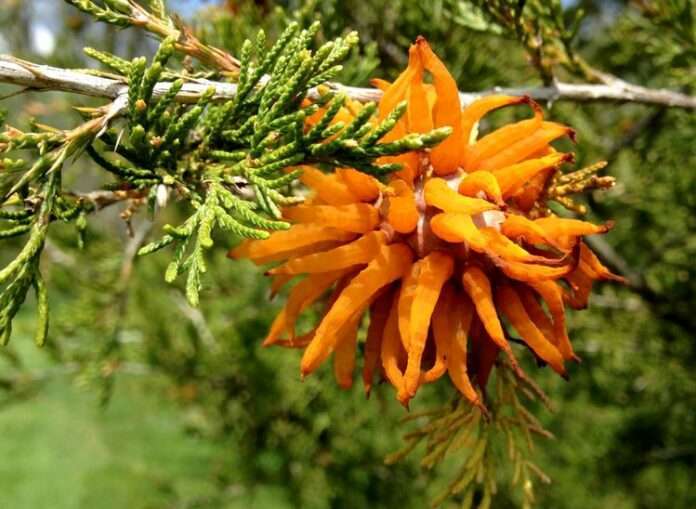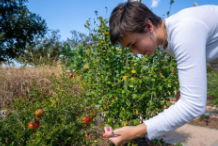What are those orange tentacle things on my juniper? They look like aliens! The answer is Cedar-apple, cedar-hawthorn, and cedar-quince rust. This time of year they are noticed and a are common diseases of apple and flowering crab in Kansas. My last several questions from homeowners asked about this problem. These rust fungi spend a portion of their life cycle on rosaceous hosts such as apple, flowering crab, and hawthorn, and another portion on species of Juniperus (which includes eastern red cedar). Cedar-apple rust is the most prevalent of the three diseases in Kansas. These rust fungi can result in considerable damage to rosaceous plants by causing premature defoliation and fruit distortion and abortion. The effects of these diseases on junipers are minimal.
Symptoms of cedar-apple rust on flowering crab and apple are easily identified. In late spring or early summer, bright, yellow-orange spots approximately 1/8 to 1/4 inch in diameter form on the upper surface of leaves. These spots gradually enlarge and turn orange. Small black fruiting structures (pycnia) of the fungus form in the center of the lesion. An orange gelatinous matrix often may be seen oozing from the fruiting structures during wet weather. Eventually, an orange, cup-like fungal structure (aecium) forms on the bottom surface of the leaf directly beneath the lesion on the upper surface. This structure has small, tube-like projections in which dusty-orange spores of the fungus are produced. Symptoms of cedar-hawthorn rust are similar to those described. Cedar-quince rust does not affect leaves but does occur on young twigs and fruit.
Leaves with numerous spots drop during the summer. Premature defoliation weakens the tree and reduces fruit set and yield the following year. Trees with severe defoliation also are susceptible to other diseases. Cedar-apple and cedar-quince rust may cause fruit lesions.
Diseased fruits develop deep pits or become distorted and usually drop before harvest. Both cedar-apple and cedar-hawthorn rusts produce reddish-brown galls on the twigs of junipers. These woody galls usually are ½ to 2 inches in diameter. In early April, galls swell and produce orange, one-inch long, gelatinous tendrils. The tendrils remain on the galls through May. Trees with numerous galls are easily identified by their bright orange cast during rainy weather. The galls of cedar-apple rust last only one season; the spent galls dry and fall from the tree during the summer months. The galls of cedar-hawthorn rust may last for several years. The cedar-quince rust produces perennial, cigar-shaped galls on the twigs and branches of juniper.
The cedar rusts overwinter in the galls on juniper. During April, galls expand and release fungal spores which can only infect the alternate rosaceous host. Infection of flowering crab and apples is favored by relatively cool temperatures (50-75 F) and prolonged leaf wetness (longer than 4-6 hours). Rust lesions begin to develop one to three weeks after infection.
Cuplike fruiting structures (aecia) form on the lower surface of apple leaves in late June and produce dusty-orange spores. These spores, which cannot re-infect the rosaceous host, are released from July through August and are carried by wind currents back to juniper.
After infection of juniper, galls develop very slowly. Only small twig swellings may be seen the spring following infection. The galls begin to enlarge during the summer but do not release spores until the following spring. The complete life cycle of cedar-apple rust takes two years.
The severity of rust infection on apple in the spring is highly dependent on weather conditions. It is also dependent on the amount of infection that occurred two years previously on juniper, since those infections eventually produce the active galls of the current year that in turn produce the spores which infect apple. A combination of a large number of active galls along with wet spring weather can result in serious infection of apple.
On apple and flowering crab: Removal of junipers within a ½- to 2-mile radius of apple orchards disrupts the life cycle of the rust fungi and has been suggested as a control measure in some states. Unfortunately, in Kansas, eradication of the alternate host becomes an impossible task because of the large native population of eastern red cedar and the wide use of junipers in windbreak and ornamental plantings. Nevertheless, homeowners should avoid planting apples or flowering crabs adjacent to junipers.
Fungicides can be applied to apple or flowering crab in the spring to prevent rust infection. The first spray should be applied as soon as the gelatinous tendrils are noticed on the cedar
galls. This typically occurs in early April in Kansas. Continue applications on a 7- to 10-day interval as long as the galls remain active (usually till the end of May). Several chemicals, including triforine (Funginex, labeled for apples only), propiconazole (Banner, Funginol RTS, Infuse Systemic Disease Control, Fertilome Liquid Systemic Fungicide) chlorothalonil (Daconil 2787, crabapple only), myclobutanil (Immunox, F-Stop Lawn & Garden Fungicide, Eagle, Systhane, Rally) and triadimefon (Bayleton, Green Light Fung-Away) are effective in controlling rust diseases. Captan, though labeled for control of apple scab, is not effective in controlling rust diseases. In areas where both rust and scab are a problem, be sure to select a fungicide or combination of fungicides which will control both diseases.
Myclobutanil (Immunox, F-Stop Lawn & Garden Fungicide, Eagle, Rally) is labeled for both scab and rust.
Note that Immunox, F-Stop Lawn & Garden Fungicide, and Eagle are labeled for both apples and crabapples and Rally is labeled for apples and not crabapples. Check fungicide labels for proper rates of application. One way to avoid fungicide sprays each year is the planting of tolerant or resistant cultivars of flowering crab and apple. Both Cockspur (Crataegus crus-galli) and Washington (C. phaenopyrum) hawthorn are reported to be resistant to cedar-hawthorn rust.
Although the presence of galls on twigs may be unsightly, rust diseases generally do not cause serious damage to junipers. Therefore, fungicide controls are not recommended. Several cultivars of juniper are available with resistance to cedar-apple rust. However, these cultivars may be susceptible to cedar-hawthorn or cedar-quince rust.





